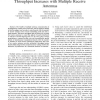97 search results - page 13 / 20 » Bounding the power rate function of wireless ad hoc networks |
ICC
2009
IEEE
14 years 2 months ago
2009
IEEE
— The benefit of multiple antenna communication is investigated in wireless ad hoc networks, and the primary finding is that throughput can be made to scale linearly with the n...
INFOCOM
2008
IEEE
14 years 2 months ago
2008
IEEE
— In this paper we study the problem of jointly performing scheduling and congestion control in mobile adhoc networks so that network queues remain bounded and the resulting flo...
INFOCOM
2006
IEEE
14 years 1 months ago
2006
IEEE
— We present in this work a new mechanism based on an innovative hybrid approach for traffic and collision control in wireless ad hoc networks. We combine the well known equatio...
MOBIHOC
2003
ACM
14 years 7 months ago
2003
ACM
A central challenge in ad hoc networks is the design of routing protocols that can adapt their behavior to frequent and rapid changes in the network. The performance of proactive ...
ICC
2007
IEEE
14 years 1 months ago
2007
IEEE
— We address a lifetime maximization problem for a single-hop wireless sensor network where multiple sensors encode and communicate their measurements of a Gaussian random source...

